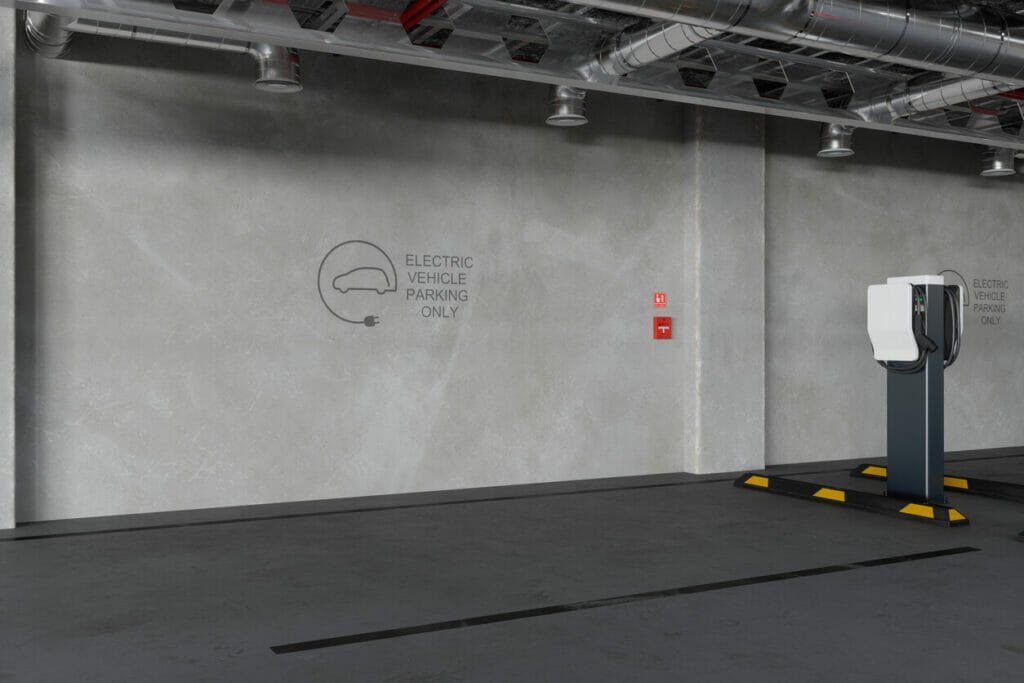Why drive an electric vehicle? Some of us have weighed the pros and cons before, but the question seems more relevant than ever. No matter where you live, the price of gas is noticeably higher than it has been in the last few years. And there’s no promise that these volatile prices will settle down to pre-pandemic numbers. The cost is so significant that it is motivating people to seriously consider making the switch from gas to electric.
According to one poll from Clean Energy Canada and Abacus Data, roughly 30% of Canadians are seriously considering purchasing an electric vehicle (EV), and 10% of people who are in the market for a new car intend to buy an EV.
This rising interest in electric vehicles is something that condominiums will have to take into account. New buildings often have a few charging stations available to the public, but older communities have a more complicated journey ahead of them. That being said, there will almost certainly come a time when EV stations become a requirement in multifamily residences. While it may not make financial sense for your community to install a charging station right now, it’s wise to at least have a plan for the future.
How to decide if an EV charging station is right for your condo
While we’d love to tell you that adding an EV charging station is a breeze, retrofitting a condominium with electric vehicle charging stations is both complex and costly, even if the corporation can get subsidies. And yet, the hardest part may be obtaining enough support from owners. This is especially true if the corporation has a lot of offsite owners who don’t really care about an EV charging station upgrade.
So, the first step is to gauge interest. There may be a few people who have asked for a charging station, but experts would advise against approving one or two requests for personal charging stations from individual owners (if possible) unless the community is relatively small. That’s because in a condo parkade, the power comes from a house panel on common property. The panel is shared, and if the corporation continues to connect charging units two or three at a time, it may find that it runs out of any additional electrical power in a few years’ time. That could create unwanted arguments between owners and the board.
Instead, if there seems to be at least a reasonable amount of interest and support, schedule a site visit with a local EV charging provider to determine the electrical availability, service options, and costs.
Service options may include:
- Visitor or public stalls that everyone can use
- Providing a station to every parking spot
- Assigning one stall at a time, with a limit on how many stalls can be added to the parking garage
- Implementing “use load sharing” technology so that more stations can be installed with the same amount of power in the electrical infrastructure
- “Smart” chargers vs. chargers that are not connected to wifi
In most cases, condos will not be able to give every parking spot an EV charging station. That would require the corporation to upgrade its entire electrical system. But providing multiple sharable stalls could be a viable solution.
If you’re concerned about making sure everyone who needs it has access to a station, you can set up a charging station pass, similar to how Condo Control handles visitor parking.
Do condos have to provide owners with an EV charging station?
This question will largely depend on local and state/provincial legislation. In California for example, a condo must allow owners to install EV charging stations (though reasonable restrictions do apply). However, the owner is responsible for paying for the installation, maintenance, and electricity use.

In Ontario, there is a stipulation under the Condominium Act that if owners request an EV charging, and they provide a condo board with sufficient documentation, an assessment must be conducted.
Below is a condensed outline of the process condo boards operating in Ontario must follow if there is a desire to install EV charging stations. You can see all of the details by visiting the Condominium Authority of Ontario.
The corporation wants to install a charging station
If a condominium corporation wants to give owners access to EV charging stations, they may be able to do so without a vote of the owners. But it’s always a better idea to obtain support from the owners for these types of decisions.
That’s because in this instance, all costs associated with the installation of the charging stations are considered common expenses of the corporation. As such, all owners (not just those with EVs) will be responsible for paying for the costs associated with the installation and ongoing maintenance of the stations. Costs will be determined based on the statement of the proportions in which owners contribute to common expenses, as set out in the corporation’s declaration.
Step 1: Figure out installation costs
The board must assess the costs of installation and maintenance.
Step 2: Determine whether owners will vote
Based on the results of the assessment, the corporation must then determine whether it can and will proceed with the installation without a vote from the owners.
The corporation can decide to install the charging stations without a vote from the owners only if the proposed installation meets two conditions:
- The estimated cost to the corporation is not greater than 10% of the annual budget for common expenses for the corporation’s current fiscal year, and
- The board believes that owners would not consider the installation of the charging stations as causing a material reduction or elimination of their use or enjoyment of the common elements
Step 3 (Option 1): Send notice to owners
Option 1 occurs if the condo is not getting a vote from owners. Instead, the corporation must send a notice to owners. The notice must contain:
- A description of the proposed installation
- A statement that the board believes this addition won’t create a material reduction or eliminate their use or enjoyment of the units they own or the common elements they use
- A statement of the estimated costs for the installation
- How the corporation will pay for the costs
- Any other information that the bylaws of the corporation require
Step 3 (Option 2): Send notice to owners
Option 2 occurs when owners have a right to requisition a meeting to vote on the proposed installation. The corporation sends out a notice to all owners with the following information:
- A description of the proposed installation
- A statement of the estimated costs for the installation
- How the corporation will pay for the costs
- A statement that the board believes this addition won’t create a material reduction or eliminate their use or enjoyment of the units they own or the common elements they use
- A statement that explains that owners have a right to requisition a meeting within 60 days of receiving the notice
- A copy of the text of section 46 of the Act, and sections 24.2 and 24.3 of Ontario Regulation 48/01
- Any other information that the bylaws of the corporation require
Step 4 (Option 1): Proceed with the installation
Once 60 days have passed since the corporation sent the notice to owners, the corporation can proceed with the installation
Step 4 (Option 2): Determine next steps
If 60 days have passed since the notice was sent, and no owner requisitioned a meeting, if someone did requisition a meeting but quorum was not present at the meeting, or if quorum was met but owners did not vote against the installation of the EV charging stations, then the corporation can move forward with installation plans.
Owners are asking for a charging station
Owners must follow a specific process and submit an application to their corporation before it will consider doing an assessment for an EV charging station.
Step 1: Create an application
Applications for EV charging stations must:
- Be in writing
- Identify the owner and their address at the condominium
- Contain their signature
- Include drawings, specifications, or information relating to the proposal
- If the owner requires information, permission, or authorization from the corporation to provide the required drawings or specifications, they can make a request in writing. Once requested, the corporation must provide this information as soon as reasonably possible
Step 2: Submit the application
After the owner has created the application, they must then send it to the corporation. The application must be sent:
- By mail, courier, or deposited in the mailbox. The application must use the address for service for the corporation, the property manager, the property management provider, or any other person responsible for the management of the property
- To an address that the board uses to receive applications for the installation of an EV charging stations
- By fax, email, or any other method of electronic communication for digital applications
- Any manner that the corporation and the owner agree to in writing
Step 3: Response from the board
Once a corporation has received an application from an owner, the board must determine if the application is complete and meets the requirements listed in Step 1 and Step 2.
If the application is complete, the board must respond to the owner in writing about their decision. The response must be sent within 60 days (or any other timeframe that the board and the owner agree to in writing).
If the board accepts the application and does not require the proposed installation to be carried out in an alternative manner or location, then the response must include a statement of that fact.
If the board rejects an application, they are required to include a copy of the report that made it necessary for them to reject the application.
A response must also be sent to owners who submit incomplete applications. The board must let them know why the application could not be considered.
Step 4: Proceed with the installation
If the board accepts an application for the installation of an EV charging station, the corporation and the owner must enter into an agreement. This agreement must be entered into within 90 days of the board accepting the application (or another timeframe that the corporation and the owner agree to in writing).
The agreement must be in writing, and terms and conditions must be reasonable and necessary to facilitate the installation, use, and operation of the charging station. The terms and conditions must:
- Address the manner of the installation
- Outline how the cost of the installation will be distributed between the owner and the corporation
- Establish the responsibilities of the corporation and the owner in relation to the usage, costs, maintenance, repair and insurance
- Address who will pay for the preparation and registration of the agreement
- Specify who has ownership of the EV charging station
- Include a clause about the termination of use of the charging station
Once signed by both parties, the agreement must be registered against the title to the owner’s unit.
Payment
In most cases, the owner is responsible for the costs of the installation and maintenance of the charging station, regardless of whether the installation is carried out by the owner or the corporation. This only changes if the corporation agrees to take on some of the costs.
Conclusion
Condos are encouraged to start thinking about EV charging stations now. Even if interest is low today, it is likely to spike in the future. Consult with a local installation company and learn more about the options, costs and benefits of EV charging stations.


